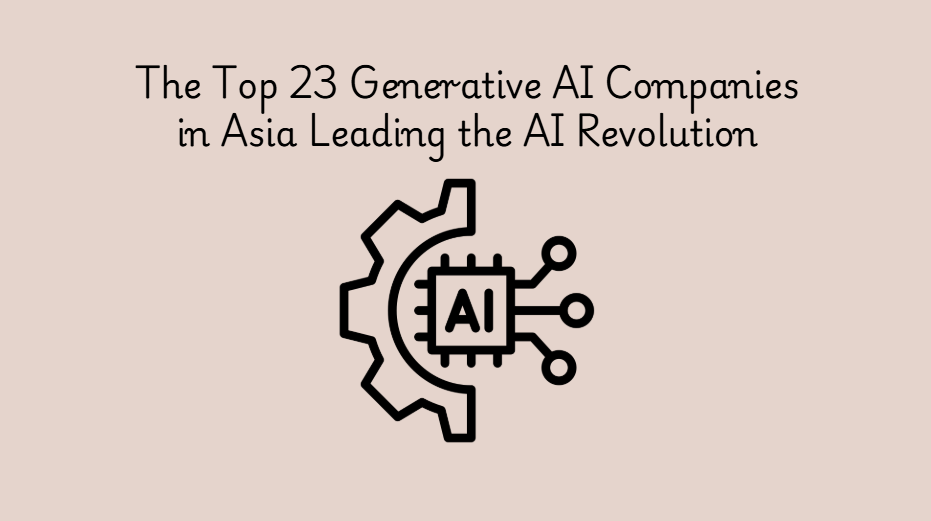While Silicon Valley and Europe have traditionally dominated AI development, Asia is now a powerhouse in generative AI. With rapid advancements in large language models, AI-powered cloud services, and multimodal AI, companies in China, Japan, South Korea, India, and Southeast Asia are pushing AI innovation to new heights.
According to IDC, China’s AI market is projected to reach $26.69 billion by 2026, accounting for approximately 8.9% of global AI investments, positioning China as the second-largest AI investor globally. Meanwhile, Japan and South Korea are focusing on AI hardware, robotics, and enterprise AI, while India and Southeast Asia are emerging as hubs for AI-driven automation and conversational AI.
This growth underscores the region’s commitment to integrating AI across various sectors, from finance and healthcare to manufacturing and entertainment.
Selection Criteria for the Top 23 Companies in Asia
In this article, we spotlight 23 companies that are at the forefront of generative AI innovation in Asia. Each company has been evaluated based on the following criteria:
- AI Innovation and Product Development – Are they building cutting-edge generative AI models and applications?
- Industry Impact – Which sectors are they transforming with AI?
- Patent Activity – Have they secured patents that demonstrate a deep investment in AI? (Where available, we’ll highlight notable patents.)
From China’s AI giants to Japan’s cutting-edge AI labs and India’s fast-growing startups, these companies are shaping the next era of generative AI.
Let’s dive in.
#1. Alibaba Group

Source: Alibaba
Founded: 1999
Headquarters: Hangzhou, China
Generative AI Initiatives:
- QwQ-32B: An open-source AI model that has demonstrated superior performance in natural language processing tasks, achieving high efficiency with less data compared to some competitors.
- Quark Assistant: An upgraded virtual assistant incorporating advanced AI capabilities, enabling tasks such as academic research and medical diagnostics. This development showcases Alibaba’s progress in AI technology and potential future integrations with devices like iPhones in China.
Industry Impact:
- Domain Transformation: Enhancing e-commerce, cloud computing, and digital services through the integration of advanced AI models, improving user experience and operational efficiency.
- Catering To: E-commerce, cloud computing, digital media, and entertainment sectors, providing AI-driven solutions to enhance customer engagement and streamline operations.
Patent Information:
Alibaba holds numerous patents in AI and related technologies, reflecting its commitment to innovation in the digital economy.
Alibaba’s strategic pivot towards AI, including significant investments and the development of advanced models like QwQ-32B, has revitalized its market position and underscores its commitment to leading in the AI domain.
The company holds 571 generative AI patents, positioning it among the top global entities in this field.
Applications and Technological Focus:
- Document Management and Publishing: Approximately 12% of Alibaba’s generative AI patents are focused on document management and publishing applications.
- Business Solutions: Alibaba has developed 91 generative AI patents aimed at enhancing business processes, reflecting the company’s commitment to integrating AI across various operational facets.
Recent Developments:
- Qwen 2 Large Language Model: In June 2024, Alibaba Cloud released its latest large language model (LLM) series, Qwen 2, which it claimed “topped rankings for open-sourced LLMs.”
Alibaba’s substantial investment in generative AI patents underscores its dedication to integrating AI across various sectors. While the volume of patents is impressive, the effectiveness of these innovations will depend on overcoming challenges related to quality, international applicability, and resource accessibility.
#2. Baidu
Founded: 2000
Headquarters: Beijing, China
Generative AI Initiatives:
- Ernie X1: A reasoning model positioned as a cost-effective alternative to existing AI models, offering enhanced understanding and planning capabilities.
- Ernie 4.5: A multimodal model that surpasses GPT-4.5 in performance while being significantly more cost-efficient.
Industry Impact:
- Domain Transformation: Integrating advanced AI models into services like Baidu Search, enhancing user experience and operational efficiency.
- Catering To: Search engines, cloud services, autonomous driving, and AI research sectors.
Patent Information:
Baidu holds numerous patents in AI and related technologies, reflecting its commitment to innovation in the digital economy.
Baidu’s advancements in AI, including the development of models like Ernie X1 and Ernie 4.5, position it as a significant player in the global AI landscape.
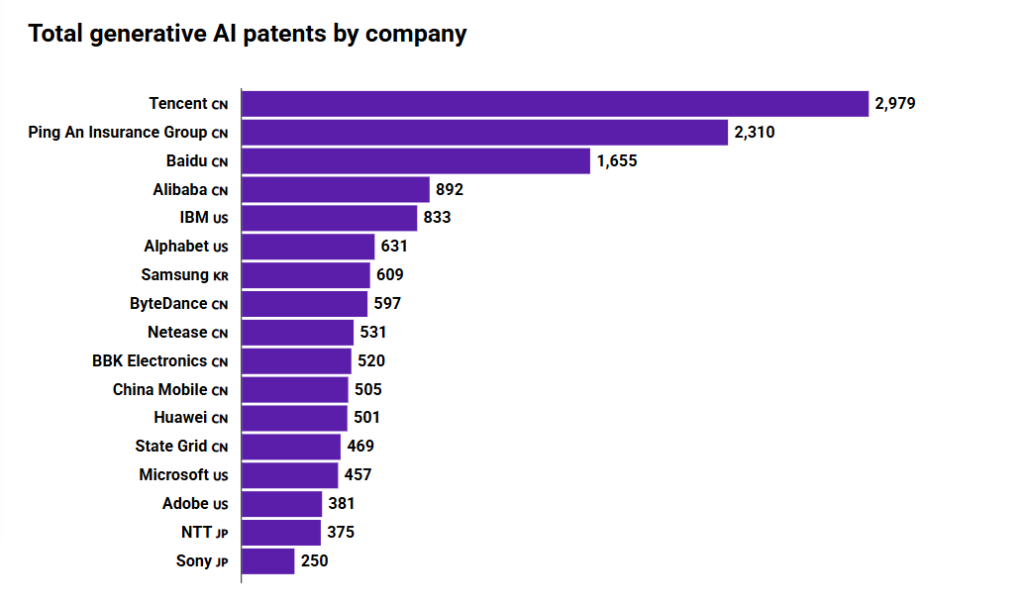
Source – Motley Fool
Global Patent Landscape:
Baidu ranks third globally in the number of generative AI patents, with 1655 patents, following Tencent (2,979) and Ping An Insurance (2,310).
#3. Tencent
Founded: 1998
Headquarters: Shenzhen, China
Generative AI Initiatives:
Hunyuan: An advanced AI model integrated into Tencent’s ecosystem, including applications like WeChat, enhancing user interactions and services.
Industry Impact:
- Domain Transformation: Enhancing social media, gaming, and cloud services through AI integration, improving user experiences and operational efficiency.
- Catering To: Social networking, gaming, cloud computing, and digital services sectors.
Patent Information:
Tencent has established itself as a dominant force in the field of generative artificial intelligence (AI) through extensive patent filings. Between 2014 and 2023, Tencent secured 2,074 generative AI patents, making it the top holder globally in this domain.
Scope and Applications of Tencent’s Generative AI Patents:
- Document Management and Publishing: Approximately 11% of Tencent’s generative AI patents are focused on document management and publishing applications.
- Business Solutions: Tencent has developed 119 generative AI patents aimed at enhancing business processes, reflecting the company’s commitment to integrating AI across various operational facets.
- Entertainment: With 90 patents in the entertainment sector, Tencent leverages generative AI to innovate in gaming, music, and multimedia content creation, aligning with its extensive portfolio in these industries.
- Life and Medical Sciences: Tencent’s 73 patents in this area indicate a strategic move to apply AI in healthcare, potentially revolutionizing diagnostics, treatment planning, and medical research.
Tencent’s advancements in AI, including the development of models like Hunyuan, position it as a significant player in the global AI landscape.
#4. Huawei

Source – Huawei
Founded: 1987
Headquarters: Shenzhen, China
Generative AI Initiatives
PanGu: A multimodal large language model developed by Huawei, designed to perform a variety of tasks across different domains, including natural language processing, computer vision, and scientific computing.
Industry Impact:
- Domain Transformation: Integrating AI into telecommunications, cloud services, and consumer electronics, enhancing operational efficiency and user experiences.
- Catering To: Telecommunications, cloud computing, and consumer electronics sectors.
Patent Information:
Huawei holds 501 generative AI patents, positioning it among the top global entities in this domain.
Applications and Technological Focus:
- Natural Language Processing (NLP): Huawei has developed advanced transformer architectures, enhancing machine comprehension of complex linguistic structures. These innovations are pivotal for applications such as translation and summarization.
- Network Security: The company has patented AI-driven systems for real-time threat detection and adaptive network defenses, addressing the increasing sophistication of cyber threats.
Strategic Collaborations and Ecosystem Development:
- Partnerships: Huawei is building a generative AI ecosystem through strategic partnerships with industry leaders such as Mianbi Intelligence, Honor, and ByteDance.
Huawei’s extensive patent portfolio and strategic initiatives reflect its dedication to advancing generative AI technologies across various sectors, reinforcing its position as a leader in the global AI landscape.
#5. Zhipu AI
Founded: 2019
Headquarters: Beijing, China
Generative AI Initiatives:
ChatGLM: A bilingual (Chinese-English) large language model series designed for natural language understanding and generation, facilitating applications such as chatbots, translation, and content creation.
Ying Video Generation Model: In July 2024, Zhipu AI launched “Ying,” a large-scale video generation model. This product enables users to create high-quality videos from text prompts, showcasing Zhipu AI’s advancements in multimodal AI capabilities.
Industry Impact:
- Domain Transformation: Enhancing human-computer interaction by providing advanced language models that support seamless bilingual communication, thereby improving user experiences in various applications.
- Catering To: Customer service, education, and content creation sectors seeking to integrate sophisticated language understanding and generation capabilities into their services.
Zhipu AI’s development of the ChatGLM series positions it as a significant contributor to the advancement of bilingual generative AI technologies in China.
Funding and Valuation:
As of September 2024, Zhipu AI was valued at approximately $2.8 billion, making it one of China’s highest-valued AI startups. The company has attracted significant investments, including a recent funding round of $411.75 million, reflecting strong investor confidence in its technological capabilities and market potential.
In summary, Zhipu AI is a leading figure in China’s generative AI landscape, contributing significantly to the development of advanced AI models and applications. The company’s initiatives, such as the Ying video generation model and the ChatGLM series, highlight its commitment to advancing AI technologies. However, specific information about its patent holdings remains undisclosed, reflecting broader trends in China’s approach to AI intellectual property.
#6. Preferred Networks

Source: Preferred Networks
Founded: 2014
Headquarters: Tokyo, Japan
Generative AI Initiatives:
- Chainer: An open-source deep learning framework developed to facilitate the creation of complex neural networks, contributing to advancements in natural language processing and computer vision.
- MN-Core: A deep learning processor designed to enhance computational efficiency for AI applications, supporting the development of large-scale generative models.
Industry Impact:
- Domain Transformation: Advancing the fields of robotics, autonomous driving, and healthcare by integrating generative AI technologies to improve automation and data analysis.
- Catering To: Manufacturing, automotive, and medical industries seeking to implement AI-driven solutions for enhanced productivity and innovation.
Patent Information:
Preferred Networks holds several patents related to deep learning technologies and applications, reflecting its commitment to AI innovation. Preferred Networks’ contributions to AI frameworks and processors have positioned it as a key player in Japan’s generative AI landscape.
#7. LG AI Research
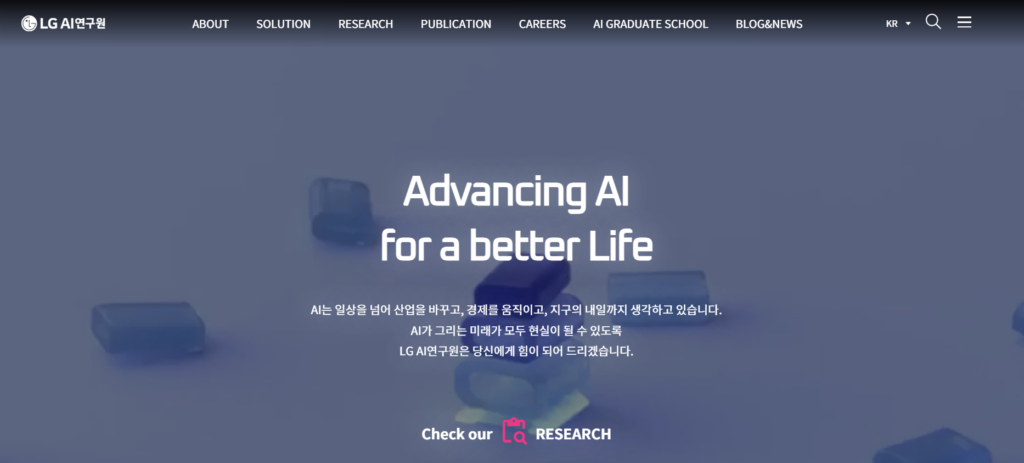
Source: LG
Founded: 2021
Headquarters: Seoul, South Korea
Generative AI Initiatives:
- EXAONE 3.0: A bilingual (Korean-English) large language model developed by LG AI Research, designed to perform a variety of natural language processing tasks, including text generation, summarization, and translation.
Industry Impact:
- Domain Transformation: Enhancing human-computer interaction by providing advanced language models that support seamless bilingual communication, thereby improving user experiences in various applications.
- Catering To: Customer service, education, and content creation sectors seeking to integrate sophisticated language understanding and generation capabilities into their services.
#8. DeepSeek
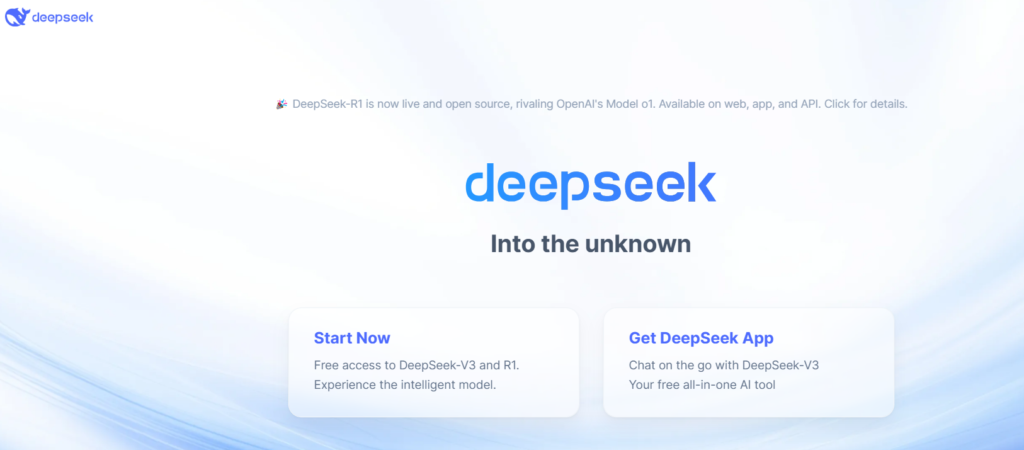
Source: DeepSeek
Founded: 2022
Headquarters: Hangzhou, China
Generative AI Initiatives:
- R1 Model: A cost-effective AI model recognized for its efficiency and performance, contributing to advancements in natural language processing and other AI applications.
Industry Impact:
- Domain Transformation: Providing accessible AI solutions that enhance various applications, including natural language understanding and data analysis.
- Catering To: Industries seeking efficient and affordable AI models for integration into their services and products.
The company is known for its advanced AI-driven search engine that transcends traditional keyword matching by understanding intent and context to deliver precise insights. This makes it a powerful tool for researchers, analysts, and professionals, leveraging deep learning and real-time data processing to uncover industry trends and technical intelligence.
Patent Portfolio:
As of February 2025, DeepSeek and its related enterprises have filed 19 invention patent applications, with seven granted. These patents encompass technologies such as cluster training management methods, data communication methods, and data storage methods, reflecting DeepSeek’s innovations in efficiency optimization. Notably, all current patent applications have been filed exclusively in China, and it remains unclear whether DeepSeek has pursued international patent protection for its innovations.
Intellectual Property Strategy:
DeepSeek employs a collaborative protection mechanism that combines trade secrets and patents, a strategy commonly used by open-source companies. While the company has open-sourced its AI models under an MIT License, it has not disclosed critical components such as the complete training dataset, training code, data processing and storage technical details, and experimental training strategies. These core competitive elements remain protected as trade secrets, allowing DeepSeek to maintain a competitive edge while fostering community collaboration.
Legal Considerations:
The rise of DeepSeek has sparked discussions about intellectual property (IP) protection in the AI industry. OpenAI, for instance, has expressed concerns that DeepSeek may have used its model outputs to train its own applications, potentially infringing on OpenAI’s IP rights. However, enforcing such claims is challenging due to the complexities surrounding AI-generated content and existing legal frameworks. Moreover, OpenAI’s relatively limited patent filing strategy leaves it with fewer legal options to assert against competitors like DeepSeek.
Global Impact and Future Outlook:
DeepSeek’s open-source approach and rapid advancements have positioned it as a disruptive force in the AI sector. The company’s success underscores the dynamic nature of AI development and the evolving strategies companies employ to protect and leverage their innovations. As the AI landscape continues to evolve, DeepSeek’s blend of open-source collaboration and strategic IP protection may serve as a model for balancing innovation with competitive advantage.
#9. Yellow.ai
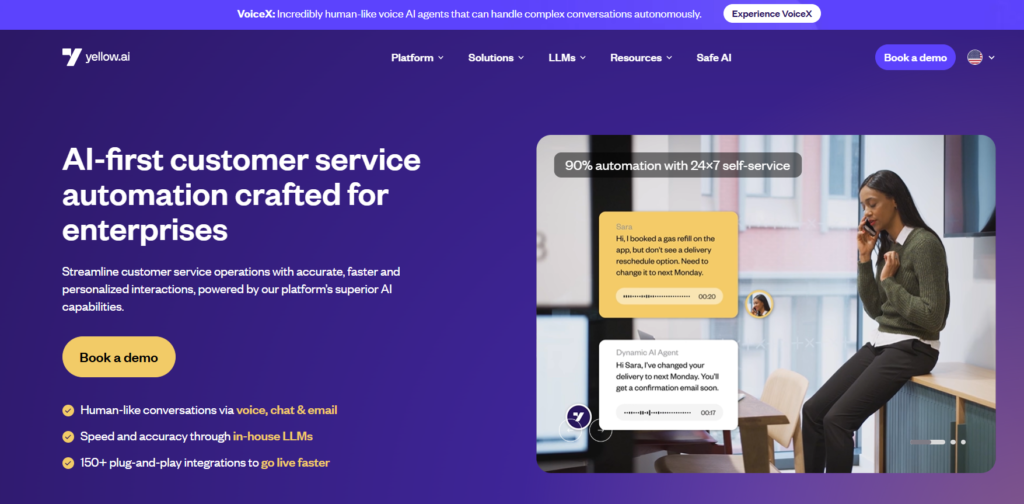
Source: Yellow
Founded: 2016
Headquarters: Bangalore, India
Generative AI Initiatives:
- Dynamic Automation Platform (DAP): A platform that leverages generative AI to automate customer experience (CX) workflows, enabling enterprises to deploy intelligent virtual assistants across multiple channels.
- YellowG: A proprietary small language model designed to enhance automation workflows, facilitating tasks such as content generation and customer interaction.
Industry Impact:
- Domain Transformation: Enhancing customer engagement and operational efficiency by integrating AI-driven automation into customer service, marketing, and internal processes.
- Catering To: Various sectors including finance, healthcare, retail, and telecommunications, serving clients like Sony, Flipkart, and HDFC Bank.
Intellectual Property and Patent Landscape:
Specific details regarding Yellow.ai’s patent holdings in generative AI are not publicly disclosed. The company emphasizes its commitment to innovation through the development of proprietary technologies, such as the YellowG platform and DynamicNLP, designed to eliminate the necessity for traditional NLP model training.
Yellow.ai’s initiatives underscore its dedication to advancing generative AI technologies, aiming to transform customer service automation and enhance user experiences across various industries.
Yellow.ai’s advancements in conversational AI and automation position it as a leading player in India’s generative AI landscape.
#10. Rebellions
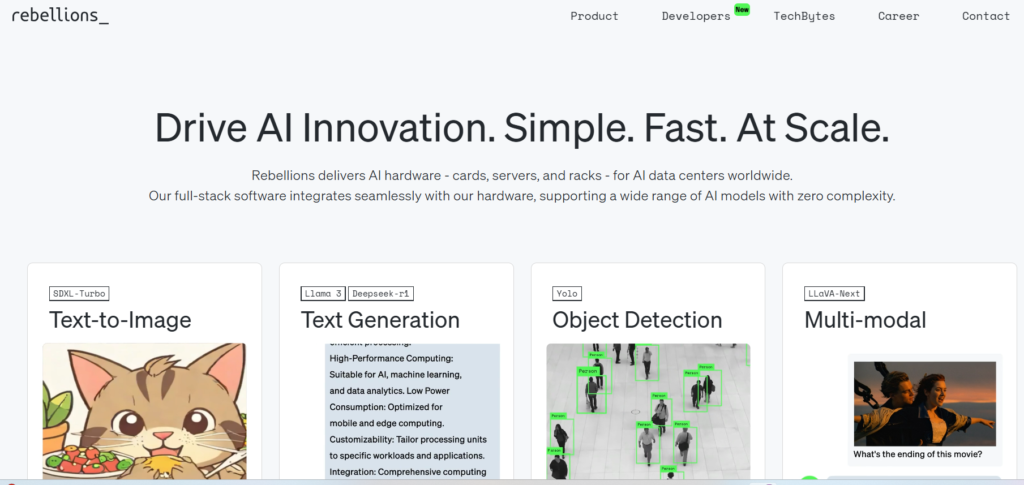
Source: Rebellions
Founded: 2020
Headquarters: Seoul, South Korea
Generative AI Initiatives:
- ATOM: A high-performance AI inference chip designed to optimize the processing of large-scale AI models, including those used for natural language processing and computer vision tasks.
Industry Impact:
- Domain Transformation: Enhancing the efficiency and scalability of AI applications by providing specialized hardware solutions, thereby reducing operational costs and energy consumption.
- Catering To: Data centers, cloud service providers, and enterprises seeking to deploy large-scale AI applications with improved performance and efficiency.
Patent Information:
Specific patent details for Rebellions’ technologies are not publicly disclosed.
Rebellions’ development of the ATOM chip positions it as a significant contributor to the advancement of AI hardware in South Korea.
#11. Observe.AI
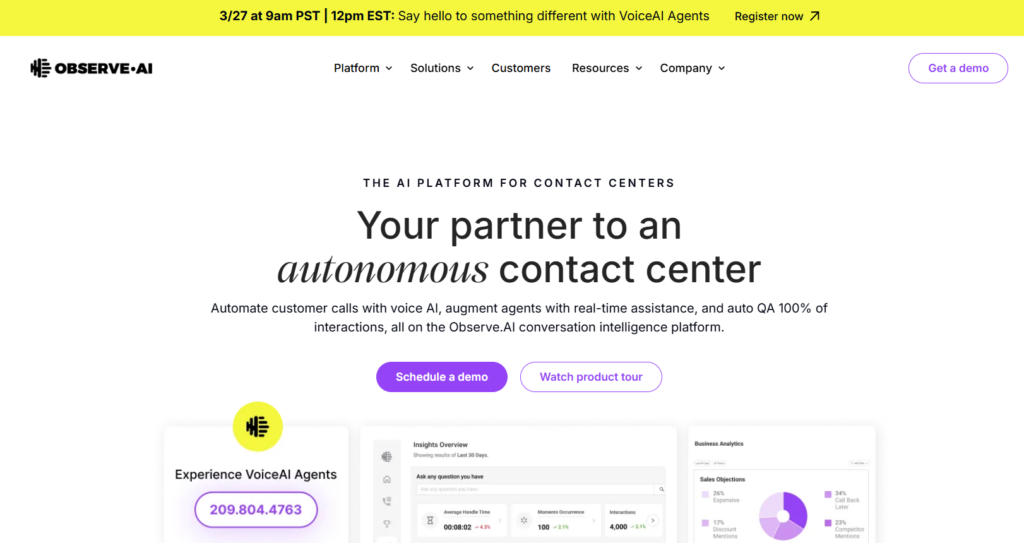
Source: Observe
Founded: 2017
Headquarters: Bangalore, India
Industry Impact:
- Domain Transformation: Improving customer service operations by providing insights and automation tools that enhance the quality and efficiency of contact center interactions.
- Catering To: Enterprises across various sectors, including telecommunications, finance, and retail, seeking to enhance their customer service capabilities.
Generative AI Initiatives:
Contact Center LLM:
In June 2023, Observe.AI introduced a proprietary 30-billion-parameter Large Language Model (LLM) specifically trained on contact center data. This domain-specific model offers greater accuracy and control compared to generic models, enhancing tasks such as call summarization and sentiment analysis.
Generative AI Suite:
- Knowledge AI: Provides agents with instant, accurate responses by integrating with existing knowledge bases, reducing average handling time (AHT) and improving first call resolution (FCR).
- Auto Summary: Automatically generates comprehensive call summaries, eliminating manual after-call work and allowing agents to focus more on customer engagement.
- Auto Coaching: Delivers immediate, AI-generated coaching notes post-interaction, facilitating rapid agent development and consistent performance improvement.
Intellectual Property and Patent Landscape:
Specific details regarding Observe.AI’s patent holdings in generative AI are not publicly disclosed. The broader landscape of patenting generative AI technologies presents opportunities and challenges, with companies needing to balance patents, trade secrets, and copyrights to protect their innovations.
Observe.AI’s integration of generative AI technologies underscores its commitment to advancing contact center operations, aiming to transform customer service automation and enhance user experiences across various industries.
#12. SenseTime
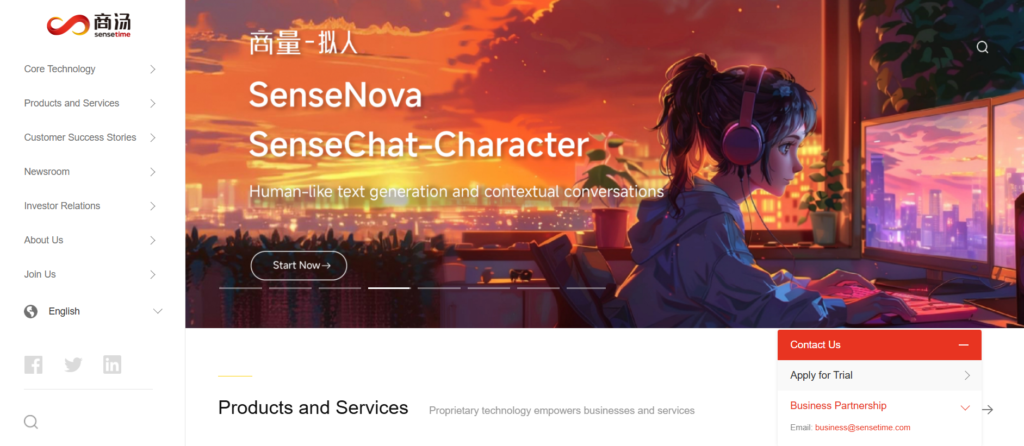
Source: SenseTime
Founded: 2014
Headquarters: Hong Kong, China
Generative AI Initiatives:
- SenseNova: An AI model introduced in April 2024, focusing on advancements in computer vision and natural language processing.
Industry Impact:
- Domain Transformation: Enhancing sectors such as security, healthcare, and finance by integrating AI-driven solutions for facial recognition, medical imaging, and data analysis.
- Catering To: Public safety, healthcare, and financial services sectors seeking to implement AI for improved efficiency and accuracy.
Strategic Shift to Generative AI:
In December 2024, SenseTime completed a major organizational restructuring to focus on generative AI technologies. This transformation reflects a redefinition of the company’s strategic direction to better address opportunities and challenges presented by AI 2.0. The restructuring introduced a new “1+X” organizational structure, with “1” representing SenseTime’s core business centered around AI model development and “X” referring to independent ecosystem enterprises focusing on specific industry solutions, including smart automotive (SenseAuto), home robotics (SenseRobot), smart healthcare, and smart retail.
Generative AI Achievements:
- Revenue Growth: SenseTime’s generative AI business recorded a remarkable 200% year-on-year increase in revenue during 2023, amounting to approximately RMB 1.2 billion (US$163.4 million). This segment accounted for over 35% of the company’s total revenue, marking it as the fastest-growing new business segment in its history.
- SenseNova Large Model Series: The company has developed the SenseNova Large Model Series, which has undergone multiple enhancements since its initial release in April 2023. These enhancements include the introduction of the SenseChat large language model, multimodal large models, edge models, and models tailored for vertical industries like healthcare and finance.
- AI Infrastructure: SenseTime’s AI infrastructure, SenseCore, has achieved a computing milestone of 12,000 petaFLOPS, with 45,000 GPUs in operation. This advancement enabled rapid iteration of the SenseNova Large Model Series to version 4.0, achieving performance parity with GPT-4 in various scenarios.
Market Position:
According to an International Data Corporation (IDC) report, SenseTime captured the second-largest market share (16%) among large model platform providers in China. This leading position is attributed to the company’s continuous investment in foundation models and its Shanghai Artificial Intelligence Data Center (AIDC), which provides integrated large model computing and application solutions.
Future Outlook:
SenseTime plans to spin off its healthcare platform to capitalize on advancements in large language models transforming AI in the medical field. The company’s AI-enabled smart hospital solution covers diagnostic and treatment assistance, AI patient services, and AI medical and hospital group services, integrating AI algorithms with advanced image post-processing technology to support clinical departments and hospitals through diagnosis, treatment, and recovery.
By embracing generative AI, SenseTime aims to drive future growth, enhance profitability, and ensure financial stability, positioning itself at the forefront of AI innovation in various sectors.
#13. Xiao-i
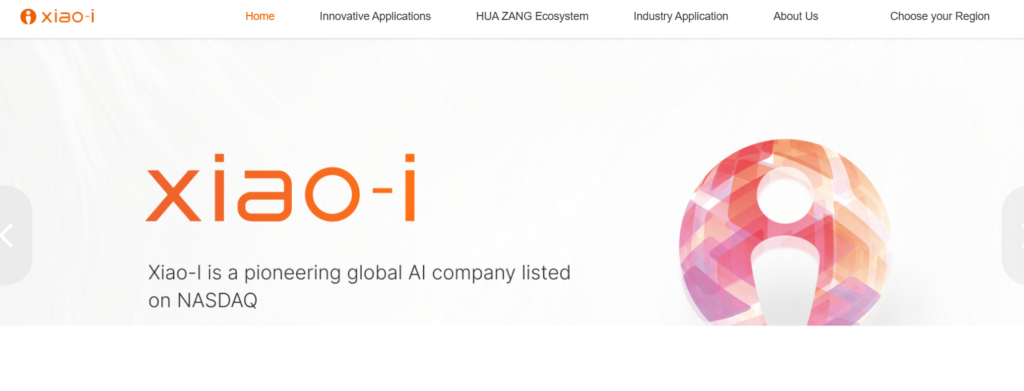
Source: Xiao
Founded: 2001
Headquarters: Shanghai, China
Generative AI Initiatives:
- Hua Zang Universal Large Language Model: Launched in June 2023, this model enhances natural language understanding and generation, supporting applications such as chatbots, virtual assistants, and content creation.
- Hua Zang Ecosystem: Introduced in October 2023, this ecosystem showcases co-creation achievements with partners across various industries, including finance, manufacturing, and human resources, leveraging the Hua Zang model’s capabilities.
Industry Impact:
- Domain Transformation: Advancing customer service, finance, and manufacturing sectors by integrating AI-driven solutions that enhance efficiency and user engagement.
- Catering To: Industries such as IoT, finance, healthcare, and manufacturing, providing AI solutions tailored to specific industry needs.
Patent Information:
As of early January 2024, Xiao-i has been granted 323 authorized patents, 137 registered software copyrights, and 248 authorized trademarks, reflecting its commitment to innovation in AI technologies.
Xiao-i’s development of the Hua Zang model and its ecosystem positions it as a significant contributor to the advancement of generative AI technologies in China.
#14. DP Technology
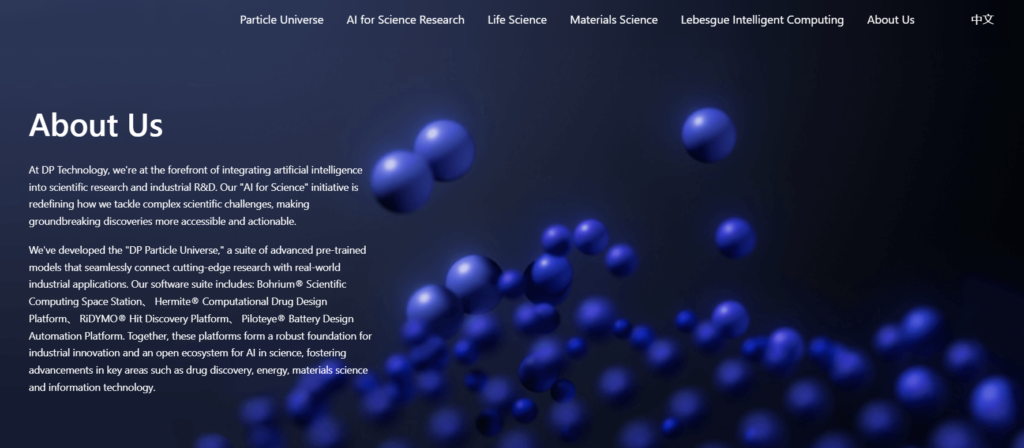
Source: DPTech
Founded: 2018
Headquarters: Beijing, China
Generative AI Initiatives:
- Molecule Pro: An AI-driven platform that utilizes generative models to accelerate drug discovery by predicting molecular properties and interactions, thereby reducing the time and cost associated with bringing new pharmaceuticals to market.
Industry Impact:
- Domain Transformation: Revolutionizing the pharmaceutical industry by integrating AI into the drug development process, enabling more efficient identification of potential drug candidates and personalized medicine approaches.
- Catering To: Pharmaceutical companies, biotechnology firms, and research institutions seeking to enhance their drug discovery pipelines and innovate in therapeutic development.
Patent Information:
Specific patent details for DP Technology’s innovations are not publicly disclosed.
DP Technology’s application of generative AI in molecular modeling and drug discovery positions it as a pioneering force in the intersection of artificial intelligence and life sciences.
#15. 01.AI
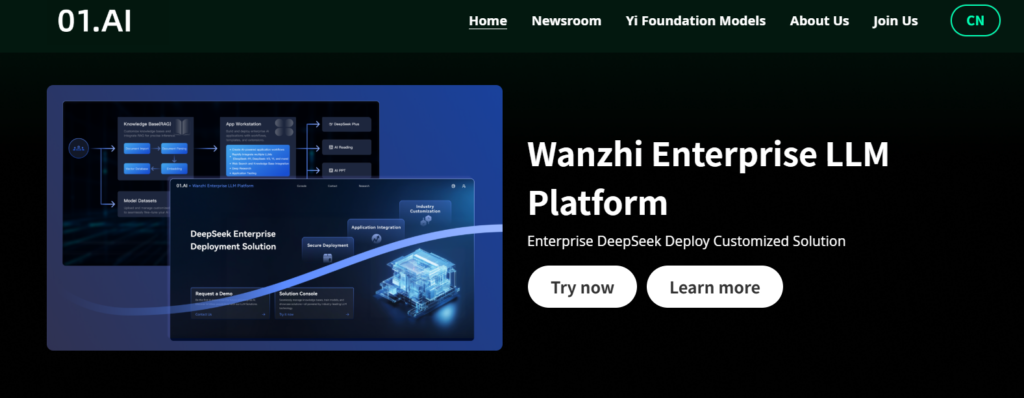
Source: 01.AI
Founded: 2022
Headquarters: Shanghai, China
Generative AI Initiatives:
- AI-Powered Solutions: Developing advanced AI models to enhance various applications, contributing to the growing AI ecosystem in China.
Industry Impact:
- Domain Transformation: Advancing AI capabilities across multiple sectors, supporting the development of innovative solutions and applications.
- Catering To: Various industries seeking to integrate AI technologies to improve efficiency and innovation.
Patent Information:
Specific patent details for 01.AI’s technologies are not publicly disclosed.
01.AI’s contributions to AI development position it as a notable player in China’s AI landscape.
#16. Sakana AI
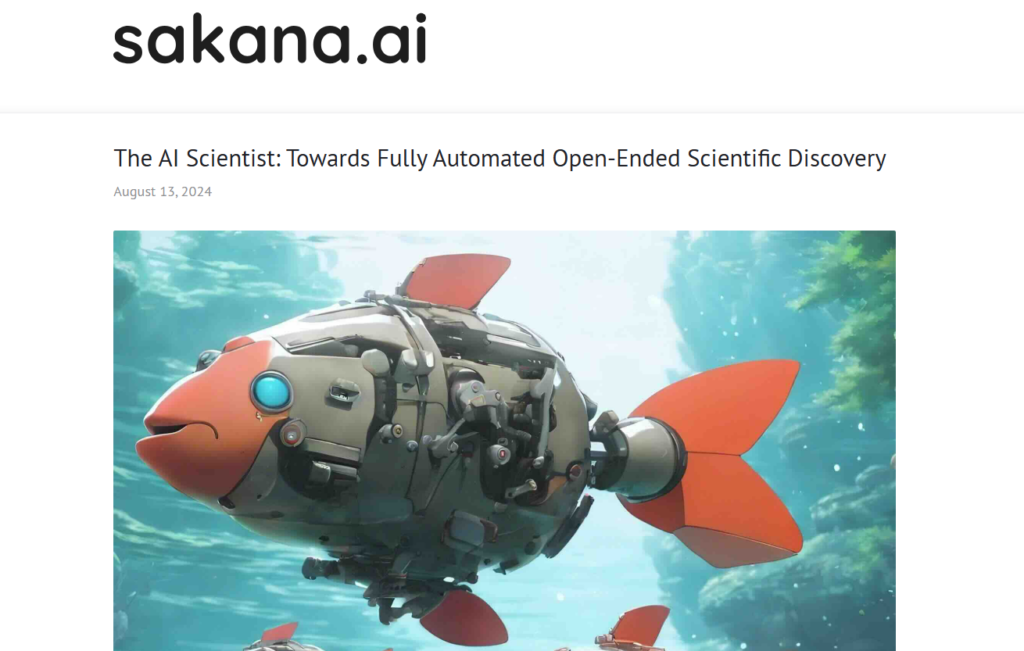
Source: Sakana
Founded: 2022
Headquarters: Tokyo, Japan
Generative AI Initiatives:
- AI-Powered Solutions: Developing advanced AI models to enhance various applications, contributing to the growing AI ecosystem in Japan.
Industry Impact:
- Domain Transformation: Advancing AI capabilities across multiple sectors, supporting the development of innovative solutions and applications.
- Catering To: Various industries seeking to integrate AI technologies to improve efficiency and innovation.
Patent Information:
Specific patent details for Sakana AI’s technologies are not publicly disclosed.
Sakana AI’s contributions to AI development position it as a notable player in Japan’s AI landscape.
#17. Foxconn

Source: Foxconn
Founded: 1974
Headquarters: Tucheng District, New Taipei, Taiwan
Generative AI Initiatives:
- FoxBrain: An in-house developed AI model capable of data analysis, mathematics, reasoning, and code generation. Initially intended for internal use, Foxconn plans to open-source FoxBrain to foster industry collaborations, particularly in manufacturing and supply-chain management.
Industry Impact:
- Domain Transformation: Enhancing manufacturing efficiency and innovation by integrating AI capabilities into production processes and supply chain management.
- Catering To: Electronics manufacturing, supply chain management, and related industries seeking to leverage AI for operational improvements.
Patent Information:
Specific patent details for FoxBrain are not publicly disclosed
Foxconn’s development of FoxBrain underscores its commitment to integrating AI into manufacturing, positioning it as a notable player in Taiwan’s AI landscape
#18. Appier
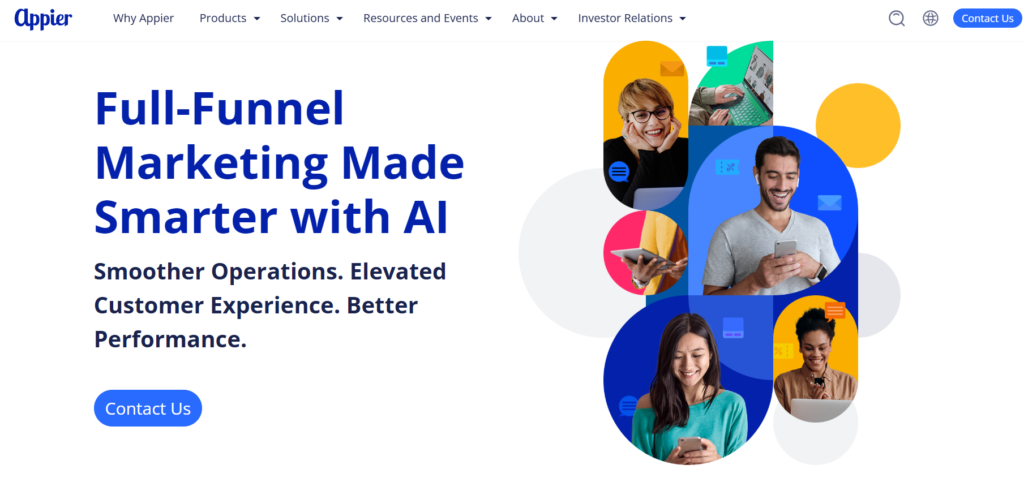
Source: Appier
Founded: 2012
Headquarters: Taipei, Taiwan
Generative AI Initiatives:
- AIQUA: An AI-powered customer engagement platform that leverages generative AI to personalize marketing campaigns, predict customer behavior, and enhance user experiences across digital channels.
Industry Impact:
- Domain Transformation: Revolutionizing digital marketing by integrating AI-driven insights to optimize customer engagement strategies, leading to higher conversion rates and customer satisfaction.
- Catering To: Retail, e-commerce, finance, and media industries seeking to enhance their digital marketing efforts through AI-driven personalization.
Patent Information:
Appier holds several patents related to AI and machine learning technologies, underscoring its commitment to innovation in the AI landscape.
Appier’s application of generative AI in marketing automation positions it as a leading player in Taiwan’s AI industry.
#19. ByteDance

Source: ByteDance
Founded: 2012
Headquarters: Beijing, China
Industry Impact:
- Domain Transformation: Integrating generative AI to improve content creation, recommendation algorithms, and user interaction within its suite of applications.
- Catering To: Social media, entertainment, and news sectors, enhancing user experiences through personalized content and interactive features.
Patent Information:
ByteDance, the parent company of TikTok, has established a significant presence in the field of generative artificial intelligence (AI) through an extensive patent portfolio and innovative applications.
Total Patents: ByteDance holds 418 generative AI patents, positioning it among the top global entities in this field.
Applications and Technological Focus:
- AI Software and Applications: A substantial portion of ByteDance’s generative AI patents are dedicated to advancements in AI software, enhancing functionalities such as content recommendation and user engagement.
- Document Management and Publishing: Approximately 10% of ByteDance’s generative AI patents focus on document management and publishing applications, reflecting the company’s commitment to integrating AI across various operational facets.
Recent Developments:
- Doubao AI Chatbot: In August 2023, ByteDance released its AI-powered chatbot, Doubao. This chatbot surpassed Baidu’s Ernie Bot in downloads and has more active monthly users on iOS, indicating ByteDance’s competitive edge in AI-driven user engagement tools.
- AI Music Initiatives: ByteDance has secured patents in the AI-music domain in the United States. The company’s researchers have developed a model trained on 257,000 hours of songs, showcasing ByteDance’s dedication to integrating AI into music creation and curation.
ByteDance’s substantial investment in generative AI patents underscores its dedication to integrating AI across various sectors. While the volume of patents is impressive, the effectiveness of these innovations will depend on overcoming challenges related to quality, international applicability, and resource accessibility.
#20. Sarvam AI

Source: Sarvam
Founded: 2021
Headquarters: Mumbai, India
Industry Impact:
- Domain Transformation: Advancing AI capabilities across multiple sectors, supporting the development of innovative solutions and applications.
- Catering To: Various industries seeking to integrate AI technologies to improve efficiency and innovation.
Sarvam AI, established in 2023, is a Bengaluru-based startup specializing in generative artificial intelligence (AI) with a focus on serving India’s diverse linguistic landscape. The company aims to develop efficient AI solutions tailored to Indian languages, emphasizing voice-enabled and multilingual technologies.
Notable Generative AI Initiatives:
Sarvam 1:
In October 2024, Sarvam AI launched “Sarvam 1,” India’s first home-grown large multilingual language model (LLM). This 2-billion-parameter model was trained on 4 trillion tokens and supports 11 languages, including Hindi, Tamil, Telugu, Malayalam, Punjabi, Odia, Gujarati, Marathi, Kannada, Bengali, and English. The development utilized NVIDIA’s technology, including H100 Tensor Core GPUs and the NeMo framework, to enhance AI accessibility across India’s linguistic diversity.
Sarvam 2B:
Sarvam AI released “Sarvam 2B,” an open-source 2-billion-parameter Indic LLM, trained on a proprietary dataset of 4 trillion tokens. This model is designed to cater to the linguistic diversity of India, supporting 10 Indian languages and aiming to make AI technologies more inclusive and accessible.
Shuka 1.0:
“Shuka 1.0” is India’s first open-source AudioLM developed by Sarvam AI. It supports Indian language voice input and provides text output with high accuracy, addressing the need for precise voice-to-text conversion in multiple Indian languages.
Funding and Collaborations:
Series A Funding:
In 2024, Sarvam AI secured $41 million in Series A funding, reflecting strong investor confidence in its mission to build generative AI that a billion Indians can use.
Partnership with NVIDIA:
Sarvam AI collaborated with NVIDIA to develop its multilingual models, leveraging NVIDIA’s full-stack AI platform, including NeMo and Hopper GPUs. This partnership showcases how tailored AI solutions can address linguistic diversity and drive inclusive technological growth in regions like India.
Intellectual Property and Patent Landscape:
Specific details regarding Sarvam AI’s patent holdings are not publicly disclosed. However, the company emphasizes building unique datasets and models for Indian languages, indicating a focus on proprietary innovations. The broader landscape of patenting generative AI technologies presents opportunities and challenges, with companies needing to balance patents, trade secrets, and copyrights to protect their innovations.
Sarvam AI’s initiatives underscore its commitment to advancing generative AI technologies tailored to India’s unique linguistic and cultural context, aiming to democratize AI access and utility across the nation.
#21. WIZ.AI
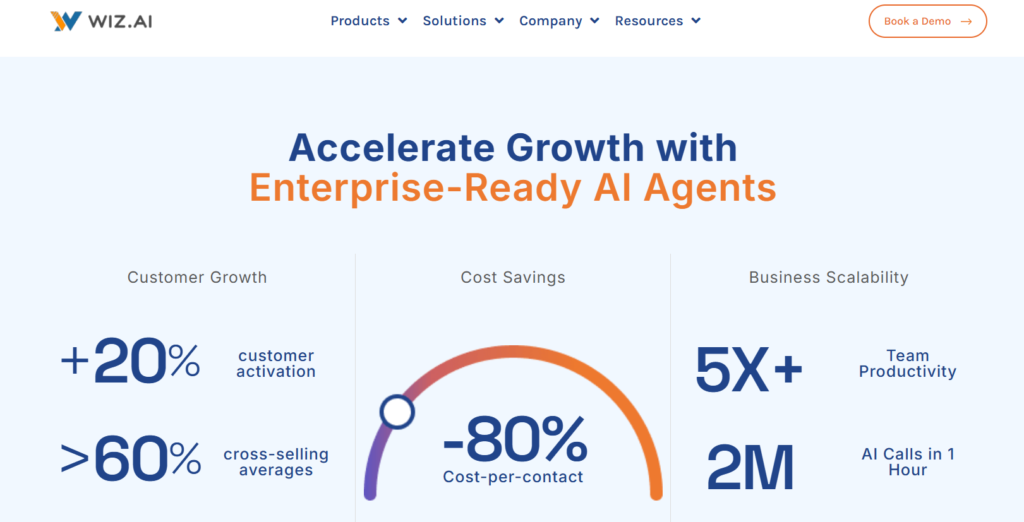
Source: Wiz.ai
WIZ.AI is a Singapore-based leader in conversational voice AI technology, specializing in human-like AI Talkbots designed to enhance customer engagement and drive business growth.
Founded: 2018
Headquarters: Singapore
Industry Impact:
Domain Transformation: Revolutionizing customer service by integrating AI-driven conversational agents, reducing response times, and enhancing user satisfaction.
Catering To: Industries such as banking, telecommunications, and retail, aiming to enhance customer engagement through AI solutions.
Patent Portfolio:
- Generative AI and Conversational AI Patents: WIZ.AI boasts a robust patent portfolio in the Generative AI and Conversational AI domains, underscoring its commitment to innovation in these fields.
- AI and Talkbot Technology Patents: The company holds over 11 patents related to AI and Talkbot technologies, reflecting its dedication to advancing voice AI solutions.
Notable Generative AI Initiatives:
- Human-Like AI Talkbots: WIZ.AI’s Talkbots are designed to deliver human-like interactions, with 95% of users unable to distinguish them from real humans. These Talkbots support multiple languages, including Bahasa, Thai, Tagalog, English, Spanish, Singlish, Portuguese, and both Simplified and Traditional Chinese, providing a natural and personalized customer experience.
- Omnichannel Customer Engagement: The company’s AI solutions facilitate seamless communication across various channels, enhancing customer satisfaction and operational efficiency.
Global Presence and Recognition:
- Clientele: Trusted by over 300 clients across 17 countries, including top brands and Fortune 500 companies in sectors such as healthcare, e-commerce, telecommunications, and banking.
- Industry Recognition: Featured in Forbes Asia’s “100 to Watch,” highlighting its innovative contributions to the AI industry.
WIZ.AI’s advancements in generative AI and conversational technologies position it as a significant player in the AI landscape, continually enhancing customer experiences through innovative solutions.
#22. MiniMax
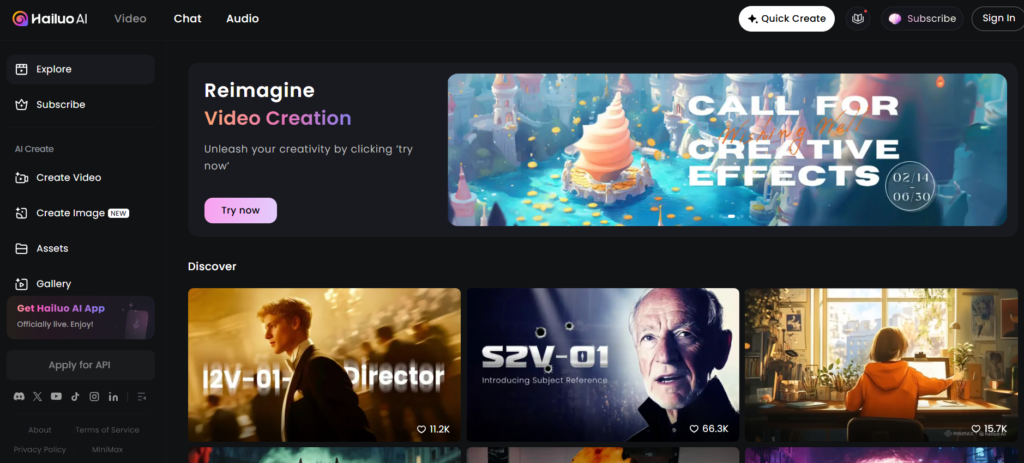
Source: Hailuo
MiniMax, founded in 2021 and based in Shanghai, China, is a prominent artificial intelligence (AI) startup specializing in large-scale model technology and content application solutions. The company focuses on developing a general artificial intelligence (AGI) engine system.
Founded: 2021
Headquarters: Shanghai, China
Generative AI Initiatives:
- Talkie: An AI-driven application allowing users to create virtual characters with unique backstories, facilitating interactive and personalized conversations.
- Hailuo AI: A multimodal large language model platform offering AI-generated text and music, with capabilities extending to text-to-video generation.
Industry Impact:
- Domain Transformation: Enhancing user engagement in entertainment and media through interactive AI applications, and advancing content creation with AI-generated media.
- Catering To: Entertainment, media, and content creation sectors seeking innovative AI-driven solutions for user interaction and content generation.
Notable Generative AI Patents:
As of January 2025, MiniMax has filed six patents related to generative AI technologies. Among these, the following are particularly noteworthy:
Plug-in Connection System for Fluid-Conducting Components:
This patent, granted on January 9, 2024, details a plug-in connection system designed for fluid-conducting components, specifically within fire extinguishing systems. The innovation aims to enhance the efficiency and reliability of such systems.
Advancements in Computer Connectors:
This patent focuses on improvements in computer connector technology, potentially contributing to more efficient hardware integrations within AI systems.
Fire Suppression Systems:
This patent pertains to innovations in fire suppression technology, which could have applications in protecting critical AI infrastructure.
Recent Developments:
Launch of MiniMax-01 LLM Series:
In January 2025, MiniMax introduced the MiniMax-01 large language model (LLM) family, including the foundational MiniMax-Text-01 and the multimodal MiniMax-VL-01 with visual capabilities. Benchmark tests indicated that these models perform comparably to leading global AI models in areas such as mathematics problem-solving, domain knowledge, and instruction adherence.
Funding and Valuation:
As of March 2024, MiniMax secured funding from investors, including Alibaba, at a valuation exceeding $2.5 billion. This investment underscores the company’s significant position in the AI industry.
#23. Alethea AI
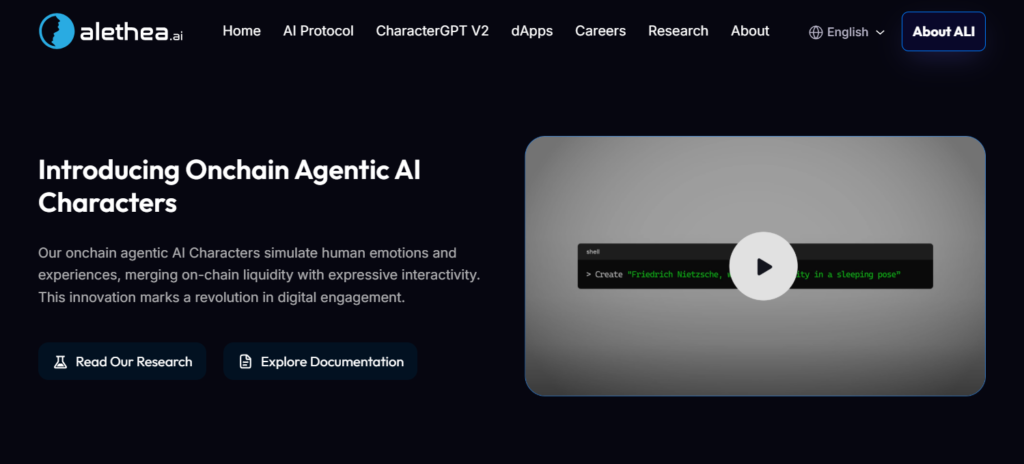
Source: Alethea
Founded: 2019
Headquarters: Singapore
Industry Impact:
- Domain Transformation: Revolutionizing the digital art and collectibles market by introducing AI-driven interactivity and personalization, thereby enhancing user engagement and value of digital assets.
- Catering To: Artists, content creators, and collectors interested in merging AI capabilities with blockchain technology to create unique, interactive digital experiences.
Alethea AI is a research and development studio operating at the intersection of generative artificial intelligence (AI) and blockchain technologies. Founded in 2020 and based in Singapore, the company focuses on creating interactive AI characters that can simulate human emotions and experiences, which are tokenizable on the blockchain.
Notable Generative AI Initiatives:
CharacterGPT:
Alethea AI developed CharacterGPT, a multimodal AI system that enables users to generate interactive AI characters from textual descriptions. This system allows for the creation of AI characters that can serve various roles, including digital twins, guides, companions, and virtual assistants.
The company introduced “The Revenants,” a collection of 100 intelligent NFTs (iNFTs) depicting historical and cultural icons, such as Nikola Tesla and Cleopatra. These iNFTs are part of Alethea AI’s effort to combine AI with blockchain, allowing for interactive and intelligent digital collectibles.
Intellectual Property and Patent Landscape:
Specific details regarding Alethea AI’s patent holdings in generative AI are not publicly disclosed. However, the company is recognized for integrating generative AI models within academically sound frameworks, promoting critical and reflective thinking among users.
Recent Developments:
Collaboration with AWS:
Alethea AI has collaborated with Amazon Web Services (AWS) to scale its infrastructure, aiming to support up to 30 million AI-generated characters. This partnership enhances the company’s ability to provide scalable AI solutions to a global audience.
Alethea AI’s initiatives highlight its commitment to advancing the integration of generative AI and blockchain technologies, offering innovative solutions that blend AI-driven interactivity with decentralized ownership.
Conclusion: AI Innovation and the Power of Patent Intelligence
The top 22 generative AI companies in Asia are leading the charge in large language models, AI automation, and multimodal intelligence. From China’s Ernie AI to India’s Sarvam AI, these companies are shaping the future of AI across industries.
But as generative AI evolves, how do businesses, researchers, and investors track real innovation?
Patent filings offer a clear signal. They reveal which companies are securing intellectual property, protecting AI breakthroughs, and gaining a competitive edge.
This is where the Global Patent Search Tool comes in. Unlike traditional patent databases, this AI-powered tool goes beyond keyword searches, enabling users to:
- Find prior art or related patents by simply describing an idea.
- Identify patents based on priority dates, mapping innovations over time.
- Analyze how a patent’s features align with existing technologies.
- Discover hidden connections between generative AI patents across industries

Whether you’re an enterprise tracking AI competitors, a researcher validating an innovation, or an investor assessing industry trends, the Global Patent Search Tool helps you uncover the real breakthroughs shaping AI’s future.
Want to explore how patents are defining the next wave of generative AI innovation? Start your search today.

